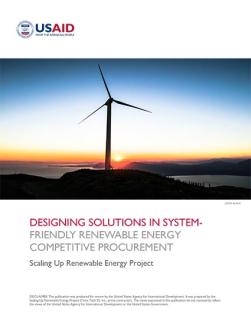Key design elements of successful, system-friendly, renewable energy procurements include time-based incentives and penalties, aggregators or virtual hybrids, procurement of physical hybrid solutions, and location-based incentives.
As auction programs mature and the share of variable renewable energy (VRE) in power systems increases, many countries find that grid integration concerns become a real barrier to scaling up renewable energy. Policymakers’ objectives often evolve from low power generation costs to enhancing dispatchability and improving the value of renewable energy. This can be accomplished by delivering renewable energy when and where it is needed and reducing integration costs.
Increasing System Value of New Renewable Energy Generation Capacity
Countries face many challenges to grid integration, such as the timing of VRE generation and energy demand, the intermittency of VRE generation (its quality), and the physical distance between VRE generation and demand centers (its location).
Policymakers can incorporate system-friendly design solutions to address grid integration challenges and to ensure a generation technology reduces relative system costs for electricity supply. Time-based incentives, location-based incentives, and virtual and physical hybrids are system-friendly design solutions that can be applied to both developed markets and less liberalized markets.
Matching the Timing of VRE Generation and Power Demand
The generation of VRE is weather dependent, resulting in seasonal and intraday patterns. Consumers may want power during the time or season that renewable energy production is limited. For example, solar energy will be generated during the day but peak demand may be at night. Auctions with system-friendly design solutions can better match the timing of VRE generation to power demand.
Policymakers can procure more dispatchable, low-cost renewable energy to meet demand reliably, even in peak demand periods through:
- Time-based incentives, such as price adjustment factors and supply blocks, which can incentivize the procurement of more dispatchable renewable energy.
- Time-of-day and time-of-year price adjustment factors that are designed to reward or punish electricity generation supplied at specific times of the day or year.
- Supply blocks that require producers to guarantee continuous delivery of electricity during certain periods, or otherwise face penalties.
- Virtual hybrids (supply-side aggregators) and, to some extent, physical hybrids as measures to address supply adequacy.
Reducing the Intermittency of VRE Generation
When integrating VRE into the power grid, conventional power plants must supply the electricity to satisfy the residual load, or the portion of the current power demand that is left after subtracting the output of VRE sources. However, it is challenging to predict the size of the load from one day to the next.
While VRE generation can be forecast, some uncertainty remains. Tools that can help reduce the residual load to be met by conventional power plants, also called “load-following generators,” include time-based incentives, tariff adjustments, supply blocks, and VRE installations combined with batteries.
Closing the Gap between VRE and Grid Infrastructure Development
Good renewable energy resources are often located far away from demand centers. Thus, renewable energy installations are often built where physical resources and land availability are highest. Auctions with system-friendly design solutions can reduce the gap between where power is fed into the grid (at the best renewable energy resource sites) and where it is needed (demand centers).
Location-based incentives steer the location of projects to specific areas and grid connection points to avoid the concentration of projects in areas that are resource-rich but costly to connect. These incentives can be based on price or quantity. They include a bonus/penalty for bids located in areas with available/insufficient grid capacities; renewable energy development zones with simpler permitting processes; capacity quotas at the regional or grid connection point; and site-specific competitive procurement.
Key Takeaways for Policymakers
- Competitive renewable energy procurement with system-friendly design elements considers renewable energy power characteristics that reduce system costs for electricity supply in the award decision.
- Which system-friendly design solutions suit a country depends on power system characteristics, such as the demand patterns, the existing generation fleet, the transmission infrastructure, and the share of renewable energy in the power mix.
- System-friendly design solutions include time-based incentives, location-based incentives, virtual hybrids, and physical hybrids.
- System integration of VRE goes beyond competitive procurement design and includes the need for power systems to become more flexible in terms of electricity transmission between regions, demand-side integration, dispatchable generation, and energy storage.
- The planning of transmission grid upgrades should occur in parallel with renewable energy development through competitive procurement.
Design solutions are not a substitute for market mechanisms but a tool to procure renewable energy power with specific characteristics.



